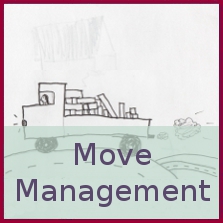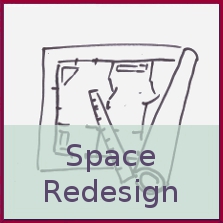Especially For Creatives - Part 3
Dear Jo the Clutterbuster:
I am so excited to be working in my studio again. Getting rid of the trash, recycling and unused materials and items made both physical as well as creative space.
But what do I do with all the paper – show announcements, competitions, seminars, letters, correspondence and bills ? It’s like living under a potential avalanche. Save me before I am buried alive.
Signed,
Mountain Climber
Dear XX:
Once you are working in your studio again, it is difficult to make time to handle paperwork. Maintaining the physical space is easier than keeping up with paperwork.
However, paper clutter is not just a minor inconvenience - it can impact the quality of your work, achievement of your goals and your relationships with clients. Most people spend up to 1 month of every year looking for things they have misplaced. Over the span of an artist’s career, that is a great deal of time that could have been spent on creating new work, talking with a potential client, applying for grants or just stopping to smell the roses.
You will apply the same space de-cluttering process to managing the paper chaos.
- Identify goals;
- Sort and determine those items to be retained or discarded; and
- Create a paper management system.
Tackling Paper Mountain
Step 1: Identify Goals
Determine the kind of “paperwork” that is required to create, document and/or distribute your work. List all the possible categories of paper: materials catalogues, ordering information, mailings, exhibition announcements, seminars, correspondence, etc.
Review your Legacy Goals to determine additional categories.
Legacy Goals:
Process
If you are more interested in art as process, you may decide to discard many of your works once you have documented them. You could then use a combination of journals/sketchbooks or computer slide shows when asked about your work.
Income
If sales and continued income form the foundation for your work, you will need to insure that all work is well cared for and kept in a climate- controlled environment and properly stored. Documenting the whereabouts of your pieces for future exhibits or historical reference requires an artist to continually organize and update the important information on each work of art.
You will also need to maintain a file on each work that includes images (disk or slides), materials used, price and providence (provenance? Are you looking for the root of its serendipity or the story of how it came into being?). An exhibition history should also be included especially if the work has won awards or was reviewed.
Teaching
If teaching is your primary focus, it is often important to retain samples of works done by previous classes. Creating a web site onto which images can be loaded following each session requires less space than storing student examples. Be rigorous about pick-up times for student works or hold an unclaimed works sale and donate the proceeds to charity.
Community
Community-based artists/creatives are often asked to spearhead projects or be a member of a board or organization. This work may include conducting research, reviewing multiple versions of designs, attending or facilitating community meetings, and amassing mountains of paper. For this kind of arts endeavor, you will need a well organized filing system, and the innate ability to manage paper and meet, often unrealistic and ever changing, deadlines.
Step 2: Sort and determine those items to be retained or discarded.
Sort ALL the paper – yes, ALL – into the categories you identified. Don’t forget the trash can as a category. Once you have sorted or discarded the various pieces of paper, you are ready to create your customized paper management system.
Step 3: Create a Paper Management System*
Your first line of defense in a Paper Management System is to keep the marauding hordes of paper from accumulating in your life. In order to be able to manage paper, it is critical to reduce the amount of paper coming in. Place a recycle bin or bag near your mailbox or the entrance to your studio. Before you hang up your coat, discard anything that you do not need to open or read. If you are worried about identity theft, place the shredder near the door and use it.
Most magazines are 60% ads so consider canceling all magazines. With so many publications on line, you might want to also cancel the newspaper, newsletters and the like. DON”T PRINT ANYTHING AVAILABLE FROM THE INTERNET – Bookmark it.
EVERYONE needs a desk or at least a space designated as a “desk.” All incoming paper i.e. bills, correspondence, exhibit invites should be kept and processed in only one location.
At a minimum, everyone needs an In and an Out box, basket or large tub. (One of my clients used his studio couch as the In-box.) Other must-haves are a calendar (or a calendar program in your computer) and a spiral notepad to track telephone calls (and responses), the results of conversations, due dates or to-do’s. This system replaces the wall as a notebook and reduces the accumulation of scraps of paper on which inscrutable notations are written.
Decide if you are a “Pile-r or “File-r.”
Some artists need to “see the stacks” to know where a particular piece of information resides. They are a “Pile-r.” To be able to locate each article readily, they keep these stacks on shelves or in clear plastic bins carefully labeled. They use bulletin boards to highlight upcoming events.
Other Creatives need a more traditional filing system. They need file cabinets and labeled folders into which papers are sorted. They are a “File-r.”
Whether you are a Pile-r or File-r, you must manage the paper accordingly and regularly. You need to make time to manage paper just as you make time to de-clutter your studio. The goal of de-cluttering is to make space for what’s important – creating art.
* For a more information about creating a Paper Management System, go to www.jotheclutterbuster.com, click on “Insights” and read about Paper Management, Filing Systems and Archives.






